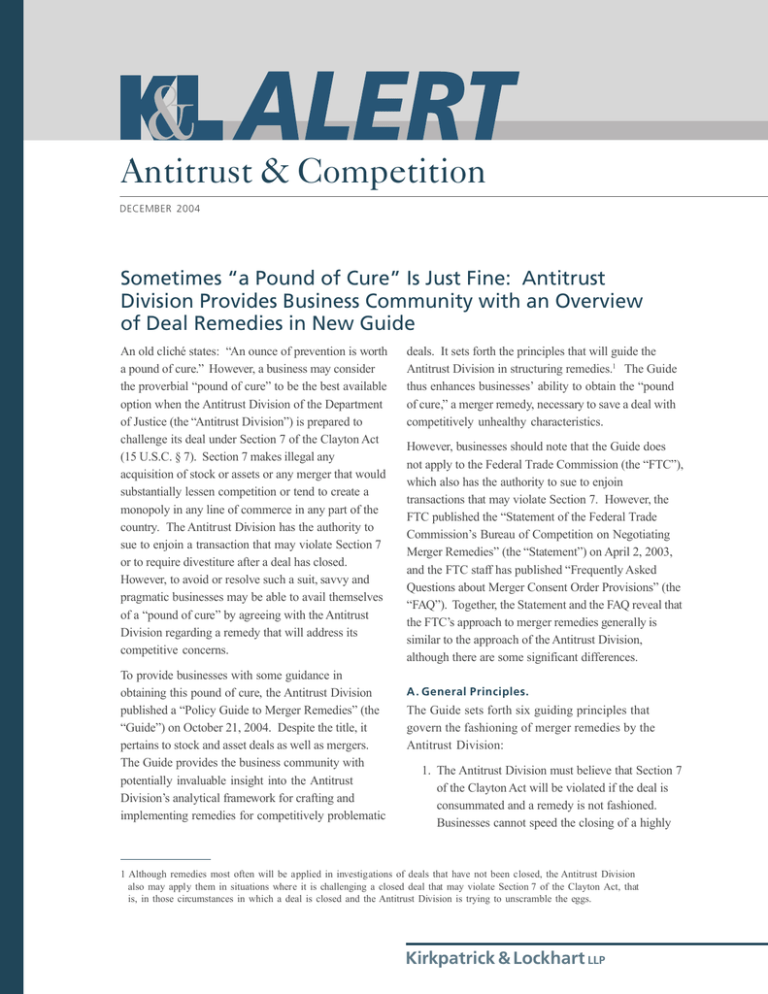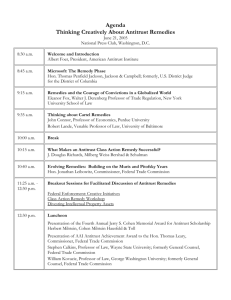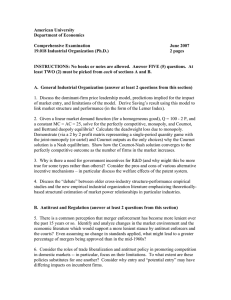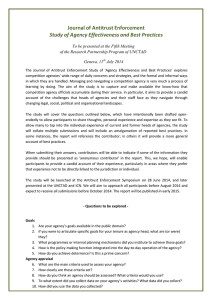
Antitrust & Competition
DECEMBER 2004
Sometimes “a Pound of Cure” Is Just Fine: Antitrust
Division Provides Business Community with an Overview
of Deal Remedies in New Guide
An old cliché states: “An ounce of prevention is worth
a pound of cure.” However, a business may consider
the proverbial “pound of cure” to be the best available
option when the Antitrust Division of the Department
of Justice (the “Antitrust Division”) is prepared to
challenge its deal under Section 7 of the Clayton Act
(15 U.S.C. § 7). Section 7 makes illegal any
acquisition of stock or assets or any merger that would
substantially lessen competition or tend to create a
monopoly in any line of commerce in any part of the
country. The Antitrust Division has the authority to
sue to enjoin a transaction that may violate Section 7
or to require divestiture after a deal has closed.
However, to avoid or resolve such a suit, savvy and
pragmatic businesses may be able to avail themselves
of a “pound of cure” by agreeing with the Antitrust
Division regarding a remedy that will address its
competitive concerns.
To provide businesses with some guidance in
obtaining this pound of cure, the Antitrust Division
published a “Policy Guide to Merger Remedies” (the
“Guide”) on October 21, 2004. Despite the title, it
pertains to stock and asset deals as well as mergers.
The Guide provides the business community with
potentially invaluable insight into the Antitrust
Division’s analytical framework for crafting and
implementing remedies for competitively problematic
deals. It sets forth the principles that will guide the
Antitrust Division in structuring remedies.1 The Guide
thus enhances businesses’ ability to obtain the “pound
of cure,” a merger remedy, necessary to save a deal with
competitively unhealthy characteristics.
However, businesses should note that the Guide does
not apply to the Federal Trade Commission (the “FTC”),
which also has the authority to sue to enjoin
transactions that may violate Section 7. However, the
FTC published the “Statement of the Federal Trade
Commission’s Bureau of Competition on Negotiating
Merger Remedies” (the “Statement”) on April 2, 2003,
and the FTC staff has published “Frequently Asked
Questions about Merger Consent Order Provisions” (the
“FAQ”). Together, the Statement and the FAQ reveal that
the FTC’s approach to merger remedies generally is
similar to the approach of the Antitrust Division,
although there are some significant differences.
A . General Principles.
The Guide sets forth six guiding principles that
govern the fashioning of merger remedies by the
Antitrust Division:
1. The Antitrust Division must believe that Section 7
of the Clayton Act will be violated if the deal is
consummated and a remedy is not fashioned.
Businesses cannot speed the closing of a highly
1 Although remedies most often will be applied in investigations of deals that have not been closed, the Antitrust Division
also may apply them in situations where it is challenging a closed deal that may violate Section 7 of the Clayton Act, that
is, in those circumstances in which a deal is closed and the Antitrust Division is trying to unscramble the eggs.
Kirkpatrick & Lockhart LLP
advantageous deal by agreeing to remedy
antitrust issues early in an investigation. Before
agreeing to any proposed remedy to alleviate
any antitrust concerns it may have, the Antitrust
Division must first be assured that the deal will
harm competition and understand how any harm
may be remedied.
2. The Antitrust Division will base remedies upon
the careful application of legal and economic
principles to the specific factual circumstances of
the deal. Effective remedies preserve efficiencies
specifically created by the deal (like reduced
costs in bringing products to market).
3. An antitrust remedy must restore competition in
the relevant market to the competitive level that
existed before the deal but need not go further to
make the relevant market more competitive than
it was before the challenged deal.
4. A remedy should restore competition in the
relevant market without favoring any particular
competitor.
5. The remedy must be specific enough to be
capable of straightforward enforcement.
6. The Antitrust Division will ensure the
enforcement of consent decrees by drafting
decrees with sufficient reporting and access
requirements to allow it successfully to monitor
their implementation.
1. Structural Remedies.
For a structural remedy, the divestiture must include all
assets necessary for the buyer to be an effective, longterm competitor and may potentially include tangible
assets, like factories, or intangible assets, like
intellectual property. The divested assets must be
sufficient to allow the buyer to compete effectively.
For example, if it will take too long for a buyer to
construct production facilities, the divested assets
should include all necessary production facilities. If
the assets being combined in the deal include a
valuable brand name or other essential intangible right,
the divested assets should include the right to use the
brand name or a license to use the essential intangible
right.
The Antitrust Division prefers the divestiture of an
existing business entity or unit, such as a subsidiary or
a plant, because its divestiture is more likely to restore
competition in the relevant market. An existing
business entity or unit typically possesses all of the
physical assets, personnel, customer lists, information
systems, intangible assets, and management
infrastructure necessary for the efficient production and
distribution of the relevant product. On the other hand,
the divestiture of less than an existing business entity
or unit is less likely to be sufficient to restore
competition in the relevant market.
Nonetheless, the Antitrust Division will consider the
divestiture of less than an existing business entity or
unit if:
B. Structural and Conduct Remedies.
Theoretically, there are two types of merger remedies,
namely, structural and conduct remedies. Structural
remedies correct the anticompetitive consequences of a
deal by restoring competition in the relevant market,
generally requiring the sale of tangible and/or
intangible assets by one or both of the parties. The
Antitrust Division vastly prefers and usually demands
structural remedies because they do not require it to
continue to monitor the conduct of the merged firm
after the deal closes. Conduct remedies require
injunctive provisions that manage the conduct of the
merged firm. The Antitrust Division dislikes and
seldom uses conduct remedies because they entangle
the government in the operation of the relevant market
on an ongoing basis.
2
1. There is no existing business entity smaller than
either of the parties to the deal, and the parties
together can divest an acceptable set of assets; or
2. The buyer already has some of the necessary
assets or can readily obtain them in a
competitive market.
Conversely, a structural remedy may require divestiture
of more than an existing business entity when such a
broader scope is necessary to establish a viable
competitor. For example, although the competitive
problem may be limited to a single product, the
divested entity may need to offer a full line of products
to compete.
KIRKPATRICK & LOCKHART LLP ANTITRUST & COMPETITION ALERT
2. Conduct Remedies.
Although they generally are disfavored, the Antitrust
Division may entertain conduct remedies, either
together with structural remedies or alone. However,
such remedies only will be used in combination with
structural remedies or in deals where the parties are at
different levels of the distribution chain (sometimes
called vertical deals) and do not compete directly with
each other.
a. Conduct Remedies Used Together with
Structural Remedies.
Together with a structural divestiture remedy, the
Antitrust Division may require a conduct remedy
whereby the seller must enter into a short-term supply
contract with the buyer when it will for a limited
duration be unable to manufacture or purchase a
critical input. Further, in combination with a
divestiture, the Antitrust Division may require a
conduct remedy whereby the seller cannot re-hire
personnel transferred to the buyer as part of a
divestiture, thereby ensuring that the buyer will have
personnel with the knowledge necessary to compete.
b. Conduct Remedies Used Alone.
The Antitrust Division may consider stand-alone
conduct remedies only if either (i) a structural remedy
is not feasible or (ii) prohibiting the deal would
prevent significant efficiencies that would result from
the deal and a structural remedy also would eliminate
those efficiencies.2 However, the Antitrust Division
remains highly reluctant to impose conduct remedies
because such remedies involve the government in the
operation of the relevant market on an ongoing basis.
Therefore, stand-alone conduct remedies are the
exception, not the rule. According to the Antitrust
Division, conduct relief alone will be limited “almost
always” to industries where there is close government
oversight, such as through regulatory agencies.
The most common kinds of stand-alone conduct
remedies are firewalls, fair dealing requirements, and
transparency provisions. These remedies are almost
always applied only in vertical deals. A firewall
provision prevents the exchange of information within
a company and may be used where an upstream
monopolist purchases one of a few downstream firms in
a relevant market. For example, a manufacturer of an
input part for military jet engines could propose to
purchase one of three manufacturers of fully-assembled
military jet engines. A fair dealing provision requires
an upstream firm that has combined with a downstream
firm to offer parts to competitors of the downstream
firm on the same terms and conditions that it provides
such parts to the downstream firm. Finally, a
transparency provision requires a merged firm to
disclose certain information to a regulatory authority.
For example, a telecommunications firm may be
required to inform a regulatory authority of what prices
the firm is charging customers for telephone
equipment.
C. The Implementation of Remedies.
The Guide states various considerations regarding the
implementation of all remedies, including the
following:
1. Before it sues to enjoin a deal, the Antitrust
Division will allow the parties to “fix-it-first” by
entering into a merger remedy that alleviates the
competitive harm that otherwise would result
from the deal.
2. A seller must hold separate from its other assets
any assets that will be divested as part of a
structural remedy.
3. The seller must sell the divested assets as quickly
as possible.
4. The Antitrust Division must approve any
proposed buyer.
5. The Antitrust Division generally disfavors socalled “crown jewel” provisions, which require
the addition of certain specified – and generally
more valuable – assets to the initial divestiture
package if the seller is unable to sell the initial
assets to a viable buyer within a specified period
of time.
2 In a vertical deal, such efficiencies could include the ability to bring the relevant product to market at vastly reduced costs.
DECEMBER 2004
Kirkpatrick & Lockhart LLP
6. The Antitrust Division will retain the right to
appoint a trustee to sell the divested assets if the
seller is unable to sell them within a prescribed
period of time.
D . Comparison of the Approaches of
the FTC and the Antitrust Division
to Merger Remedies.
additional assets if the sale of the initial assets is not
completed within a specified period of time.
Additionally, unlike the Antitrust Division, the FTC
does not expressly endorse a “fix-it-first” approach to
remedies.
CONCLUSION
There are similarities and differences between the
Antitrust Division’s and the FTC’s respective
approaches to remedies. As expressed in the Statement
and the FAQ, the FTC’s approach to merger remedies
agrees with the Antitrust Division’s approach on the
following major points:
1. Any remedy should restore competition in the
relevant market to the level that it was at before
the deal.
2. Divestitures of existing business entities or units
are preferred.
Businesses in a free-market system generally presume
that they have the freedom to acquire and sell assets
upon their sole discretion. Therefore, it may appear
counterintuitive that a forced sale of certain business
assets mandated by a government department could
ever be a positive development. However, given the
choice, a business with the opportunity to acquire and
retain a valuable business opportunity likely would
prefer healing the deal with a “pound of cure,” a
government-prescribed merger remedy, instead of
suffering the death of the deal upon the issuance of a
court injunction.
3. Competent buyers who will use divested assets
in the relevant market are necessary to preserve
competition in the relevant market.
MATTHEW R. D’ASCENZO
mdascenzo@kl.com
412.355.6549
JAMES E. SCHEUERMANN
4. Remedies should include “hold separate”
provisions.
jscheuermann@kl.com
412.355.6215
The FTC’s approach differs from the Antitrust
Division’s approach primarily by advocating “crown
jewel” provisions, which require the seller to sell
THOMAS A. DONOVAN
tdonovan@kl.com
412.355.6466
K&L’s Antitrust and Trade Regulation practice provides
comprehensive antitrust counseling to clients on achieving
business objectives while complying with the antitrust laws.
If you have any questions regarding the subject matter discussed
in this Alert, please contact one of the following attorneys:
James E. Scheuermann
412.355.6215 jscheuermann@kl.com
Thomas A. Donovan
412.355.6466 tdonovan@kl.com
Christopher O.B. Wright 415.249.1083 cobwright@kl.com
The attorneys resident in all offices, unless otherwise indicated,
are not certified by the Texas Board of Legal Specialization.
®
Kirkpatrick & Lockhart LLP
Challenge us. ®
BOSTON
■
DALLAS
■
HARRISBURG
■
LOS ANGELES
■
MIAMI
■
NEWARK
■
NEW YORK
■
PITTSBURGH
■
SAN FRANCISCO
■
WASHINGTON
.........................................................................................................................................................
This publication/newsletter is for informational purposes and does not contain or convey legal advice. The information herein
should not be used or relied upon in regard to any particular facts or circumstances without first consulting with a lawyer.
© 2004 KIRKPATRICK & LOCKHART LLP.
ALL RIGHTS RESERVED.





